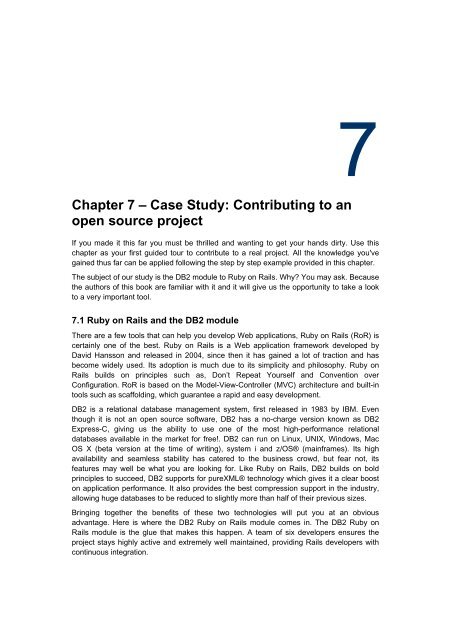Getting Started with Open Source Development
Create successful ePaper yourself
Turn your PDF publications into a flip-book with our unique Google optimized e-Paper software.
7<br />
Chapter 7 – Case Study: Contributing to an<br />
open source project<br />
If you made it this far you must be thrilled and wanting to get your hands dirty. Use this<br />
chapter as your first guided tour to contribute to a real project. All the knowledge you've<br />
gained thus far can be applied following the step by step example provided in this chapter.<br />
The subject of our study is the DB2 module to Ruby on Rails. Why? You may ask. Because<br />
the authors of this book are familiar <strong>with</strong> it and it will give us the opportunity to take a look<br />
to a very important tool.<br />
7.1 Ruby on Rails and the DB2 module<br />
There are a few tools that can help you develop Web applications, Ruby on Rails (RoR) is<br />
certainly one of the best. Ruby on Rails is a Web application framework developed by<br />
David Hansson and released in 2004, since then it has gained a lot of traction and has<br />
become widely used. Its adoption is much due to its simplicity and philosophy. Ruby on<br />
Rails builds on principles such as, Don’t Repeat Yourself and Convention over<br />
Configuration. RoR is based on the Model-View-Controller (MVC) architecture and built-in<br />
tools such as scaffolding, which guarantee a rapid and easy development.<br />
DB2 is a relational database management system, first released in 1983 by IBM. Even<br />
though it is not an open source software, DB2 has a no-charge version known as DB2<br />
Express-C, giving us the ability to use one of the most high-performance relational<br />
databases available in the market for free!. DB2 can run on Linux, UNIX, Windows, Mac<br />
OS X (beta version at the time of writing), system i and z/OS® (mainframes). Its high<br />
availability and seamless stability has catered to the business crowd, but fear not, its<br />
features may well be what you are looking for. Like Ruby on Rails, DB2 builds on bold<br />
principles to succeed, DB2 supports for pureXML® technology which gives it a clear boost<br />
on application performance. It also provides the best compression support in the industry,<br />
allowing huge databases to be reduced to slightly more than half of their previous sizes.<br />
Bringing together the benefits of these two technologies will put you at an obvious<br />
advantage. Here is where the DB2 Ruby on Rails module comes in. The DB2 Ruby on<br />
Rails module is the glue that makes this happen. A team of six developers ensures the<br />
project stays highly active and extremely well maintained, providing Rails developers <strong>with</strong><br />
continuous integration.

















